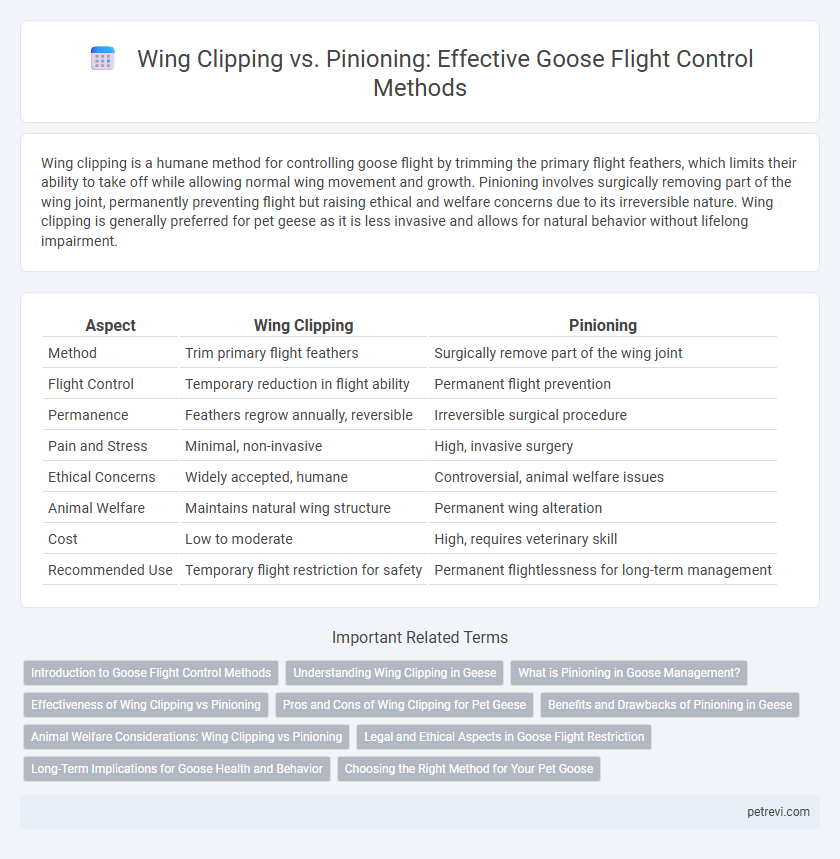Wing clipping is a humane method for controlling goose flight by trimming the primary flight feathers, which limits their ability to take off while allowing normal wing movement and growth. Pinioning involves surgically removing part of the wing joint, permanently preventing flight but raising ethical and welfare concerns due to its irreversible nature. Wing clipping is generally preferred for pet geese as it is less invasive and allows for natural behavior without lifelong impairment.
Table of Comparison
| Aspect | Wing Clipping | Pinioning |
|---|---|---|
| Method | Trim primary flight feathers | Surgically remove part of the wing joint |
| Flight Control | Temporary reduction in flight ability | Permanent flight prevention |
| Permanence | Feathers regrow annually, reversible | Irreversible surgical procedure |
| Pain and Stress | Minimal, non-invasive | High, invasive surgery |
| Ethical Concerns | Widely accepted, humane | Controversial, animal welfare issues |
| Animal Welfare | Maintains natural wing structure | Permanent wing alteration |
| Cost | Low to moderate | High, requires veterinary skill |
| Recommended Use | Temporary flight restriction for safety | Permanent flightlessness for long-term management |
Introduction to Goose Flight Control Methods
Wing clipping and pinioning are common methods used to manage goose flight risks and movements. Wing clipping involves trimming primary flight feathers to reduce lift without causing permanent damage, allowing controlled flight limitations during molting periods. Pinioning is a more permanent surgical procedure that removes or damages wing joints, effectively preventing flight but raising ethical and welfare concerns.
Understanding Wing Clipping in Geese
Wing clipping in geese involves trimming the primary flight feathers to reduce their ability to fly, providing a humane alternative to pinioning, which permanently removes part of the wing joint. This method preserves feather regrowth and minimizes long-term harm while effectively controlling flight capabilities. Regular maintenance of clipped wings is essential for sustained flight restriction and the overall well-being of domesticated or managed geese.
What is Pinioning in Goose Management?
Pinioning in goose management involves surgically removing the pinion joint, which permanently disables the bird's ability to fly by preventing the full extension of the wing. This procedure differs from wing clipping, which is a temporary flight control method achieved by trimming primary feathers. Pinioning is considered a permanent solution for controlling flight in geese, often used in situations where escape must be completely prevented.
Effectiveness of Wing Clipping vs Pinioning
Wing clipping effectively reduces a goose's ability to achieve sustained flight by trimming primary feathers, allowing controlled mobility and safer handling without permanent damage. Pinioning involves surgically removing the pinion joint, permanently preventing flight but raising ethical concerns and limiting natural behaviors. While wing clipping offers reversible control suitable for welfare, pinioning ensures complete flight prevention at the cost of the bird's long-term flight capability.
Pros and Cons of Wing Clipping for Pet Geese
Wing clipping for pet geese offers a non-permanent method to prevent flight by trimming primary feathers, allowing natural regrowth and maintaining bird comfort. This technique reduces the risk of injury associated with pinioning, a surgical and irreversible procedure that removes part of the wing joint. However, wing clipping requires regular maintenance and may cause temporary imbalance, while pinioning permanently disables flight but eliminates repeated care needs.
Benefits and Drawbacks of Pinioning in Geese
Pinioning in geese involves surgically removing the pinion joint to prevent flight, offering a permanent method of flight control that eliminates escape risks and reduces injury compared to wing clipping. However, the procedure is irreversible, can cause initial distress and potential complications, and raises ethical concerns regarding animal welfare. While pinioning provides effective long-term flight management, it limits the bird's natural behaviors and requires careful consideration of its impact on the goose's quality of life.
Animal Welfare Considerations: Wing Clipping vs Pinioning
Wing clipping offers a temporary and less invasive method for controlling goose flight by trimming primary feathers, allowing normal regrowth and minimizing physical trauma. Pinioning involves the permanent removal of a portion of the wing joint, resulting in irreversible loss of flight capability but raising significant animal welfare concerns due to its permanence and potential for pain. Evaluating impact on mobility, stress, and long-term health is critical for ethical management, with wing clipping favored for preserving welfare while effectively limiting flight.
Legal and Ethical Aspects in Goose Flight Restriction
Wing clipping and pinioning are common methods for controlling goose flight, but legal restrictions vary widely depending on regional wildlife protection laws and animal welfare regulations. Wing clipping is generally considered more ethical and legally acceptable as it temporarily limits flight without permanently altering the bird's anatomy, unlike pinioning, which involves surgical removal of part of the wing and is often banned due to animal cruelty concerns. Ethical guidelines increasingly favor non-invasive methods to ensure the welfare of geese, aligning with evolving legislation that prioritizes humane treatment and conservation efforts.
Long-Term Implications for Goose Health and Behavior
Wing clipping in geese involves trimming the flight feathers to prevent flight temporarily, minimizing stress and allowing natural regrowth, which supports long-term feather health and normal behavior patterns. Pinioning, a permanent method removing part of the wing joint, restricts flight permanently but can cause lasting physical and psychological harm, including altered social interactions and increased vulnerability to predators. Long-term implications favor wing clipping due to its reversible nature and preservation of natural behaviors critical for overall goose well-being.
Choosing the Right Method for Your Pet Goose
Wing clipping for geese involves trimming specific flight feathers to prevent full flight while allowing safe movement, making it a reversible and less invasive option for pet owners. Pinioning permanently disables flight by surgically removing part of the wing joint, ensuring no flight but raising ethical and welfare concerns due to its irreversible nature. Selecting the right method depends on balancing the need for flight control with the goose's well-being, habitat, and owner preferences, prioritizing humane and non-permanent approaches whenever possible.
Wing clipping vs Pinioning for Goose flight control Infographic

 petrevi.com
petrevi.com